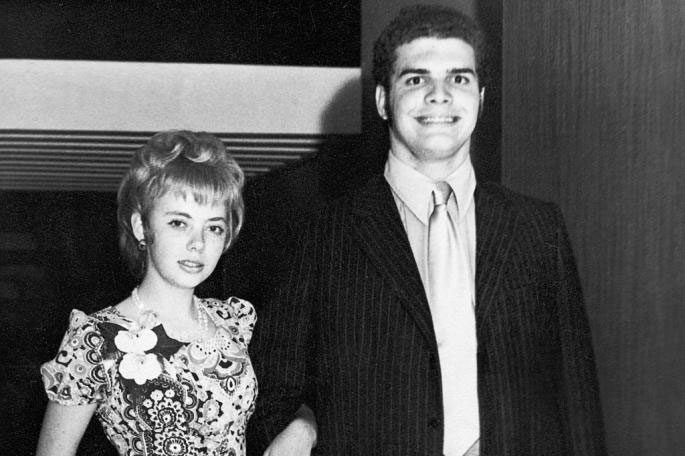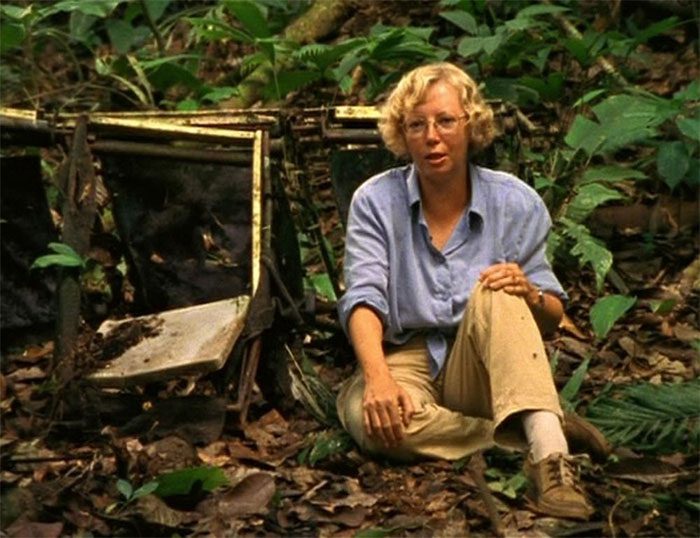The improbable survival of Juliane Koepcke has become the subject of much speculation.
At 6 PM on December 24, 1971, Juliane Koepcke, a 17-year-old girl, and her mother, Maria von Mikulicz Radecki, a German zoologist, along with 90 other passengers, boarded the four-engine Lockheed Electra 508 operated by Lansa Airlines, Peru. Their flight was from Lima, the capital of Peru, to the city of Pucallpa, located in the Amazon rainforest.
Twenty-five minutes later, the plane was struck by lightning. It plummeted to the ground and shattered. Only Juliane Koepcke survived under horrifying conditions…
The Fateful Flight
At 6:20 PM on December 24, 1971, the Lockheed Electra 508 took off from Lima Airport with 92 passengers and 5 crew members on board. Juliane Koepcke recalled: “I knew flying with Lansa wasn’t very safe as they had experienced two previous accidents. However, eager to meet my father on Christmas Eve and with no other flights available, my mother and I decided to go ahead…”

Juliane Koepcke with her father on the day of her high school graduation, two weeks before the plane crash.
Born on October 10, 1954, in Lima, Peru, Juliane Koepcke was the daughter of Hans-Wilhelm Koepcke and Maria von Mikulicz Radecki, both German zoologists. They came to Peru to study the life cycle and habits of wildlife in the tropical rainforest.
Two weeks before the Lockheed Electra 508 accident, Juliane’s father was attaching tracking chips to some capuchin monkeys at his research facility in Pucallpa, while she had just graduated from high school. Juliane intended to follow in her family’s tradition and become a zoologist as well.
The first 20 minutes of the flight went smoothly, but at 4:45 PM, the Lockheed Electra encountered a severe thunderstorm. Juliane Koepcke recounted: “Suddenly, we were surrounded by an endless stretch of dark clouds, and within that ominous cloud, flashes of green lightning were continuously lighting up. My mother, sitting next to me, turned pale as the plane shook violently, especially when luggage like suitcases, bags, parcels, fruits, and even Christmas cakes fell from the overhead compartments. Some passengers cried, others prayed, and some screamed in panic…”
Ten minutes later, through the window, Juliane Koepcke saw a lightning strike hit the engine on the left wing. She recalled: “My mother clutched my shoulder tightly, saying, ‘It’s over, it’s over, my child.’ That was the last thing I heard from her.”
Struck by lightning, the left wing of the Lockheed Electra caught fire. Seconds later, it fell to the ground from 3,200 meters. The fuselage broke into many pieces, scattered over an area of about one square kilometer. Juliane Koepcke’s final sensation was: “The wind howled in my ears, and then I knew nothing more.”
Survival in Horror
At 9 AM the next day, Juliane Koepcke opened her eyes. The first thing she realized was that she had been unconscious for over 12 hours, based on the watch on her wrist. Lying on the ground, Juliane Koepcke was still strapped to her seat by a safety belt around her waist. It was thanks to the seat and the belt that she survived.

Juliane Koepcke leaving the hospital in Pucallpa to return to Germany.
It took nearly 15 minutes for Juliane Koepcke to unbuckle the strap. She said: “I couldn’t lift my left arm because my collarbone was broken, and my right arm had a large wound. My legs also had several injuries. My right eye was swollen, and my glasses had flown off, so everything I saw was blurry.”
Crawling out of her seat, Juliane Koepcke called out for her mother. Around her lay mangled corpses. Juliane Koepcke felt almost numb as it was the first time she had seen so many dead people. She thought her mother might be among them, but when she poked a stick into the body of a woman, she noticed her toenails were painted red. She said: “Immediately, I felt relieved because my mother never painted her nails, but then I felt guilty for that thought.”
By noon, Juliane Koepcke found her mother, who had sustained injuries to her neck, chest, and abdomen, about 300 meters from where she had fallen. She said: “At that moment, I knew I was the only one left from the plane. Based on the flight duration, I estimated I was about 50 kilometers from Pucallpa, where my father’s research station was located. I hoped the rescue teams would find me quickly, but looking around, I saw that the crash site was a dense jungle, with large tree canopies interlacing to block sunlight, and the underbrush forming a maze. Therefore, I had to save myself before I could be rescued…”
By late afternoon, Juliane Koepcke gathered a few bottles of water, a pack of 50 candies, some apples, and broken pieces of Christmas cakes. As night fell, she crawled into a piece of the plane shaped like a turtle shell. She said: “When the plane crashed, I was only wearing a short dress and a short-sleeved shirt, so I couldn’t sleep because I was too cold and because mosquitoes and insects kept landing on my open wounds.”
The next morning, Juliane Koepcke decided to find her way out of the jungle. Besides losing her glasses, she had also lost one shoe, so she took a piece of clothing from a victim and wrapped it around her foot. With another piece of clothing from a victim, Juliane Koepcke made a pouch to hold the food she had collected. Using a dry branch as a walking stick, she carefully stepped until she came across a small stream, where she found three seats and three passengers dead face down in the mud.
Juliane Koepcke said: “I remembered my father teaching me: ‘If you get lost in the jungle and find a stream, follow it. Small streams lead to larger rivers, and large rivers lead to places where people live on both banks,’ so I decided to follow the stream.”
In the following five days, Juliane Koepcke heard the sound of planes overhead several times, but she couldn’t see them because the rainforest was too dense, and rescue teams also failed to locate the site where the Lockheed Electra 508 had crashed. Many times, she encountered venomous snakes and once had to take a long detour around the stream because she saw crocodiles lying with their mouths open waiting for prey. The most horrifying part was that the wound on her right arm began to develop maggots, tiny white maggots crowding together in a hole the size of a coin.

In 1980, Juliane Koepcke returned to visit the crash site.
Moreover, the foul odor of the wound attracted flies. Juliane Koepcke recounted: “Although I covered it with a piece of cloth, the flies kept landing on it. I also tried soaking my arm in the stream for an hour, hoping the maggots would crawl out, but they burrowed in deeper.”
Escape from Death
On the ninth day after leaving the wreckage of the Lockheed Electra 508, Juliane Koepcke reached the junction between the stream and a river. There, she found a small wooden boat with an engine but no one around, tied to a tree on the bank.
After waiting all day without seeing anyone, Juliane Koepcke thought about using the boat to drift downstream in hopes of finding a village. However, she was so weak that she could not even pull the rope to start the engine, and she couldn’t untie the rope securing the boat to the tree.
She recalled: “I lay at the bow of the boat so that I could be easily seen if anyone passed by. Then, I remembered a story about how my father once used kerosene to clean a wound on a dog that got infected. With all my strength, I crawled to where the engine was, opened the fuel tank with a piece of cloth, dipped it in, and squeezed drops of gasoline onto the wound…”
According to Juliane Koepcke, after applying gasoline to the wound, she counted 35 maggots crawling out. Later, when she was rescued, the hospital in Pucallpa removed an additional 50.
On the morning of January 3, 1972 – ten days after the plane crash, a group of loggers found Juliane Koepcke lying unconscious in the wooden boat. It took them seven hours to navigate upstream along the Amazon to get her to a lumber processing facility in Tournavista. After providing first aid and checking her identification, they called her father. Subsequently, a helicopter transported her to a hospital in Pucallpa. After a few days of treatment there, her father brought her back to Germany.
Based on Juliane Koepcke’s directions, on January 12, 1972, rescue teams found the crash site. However, most of the victims’ bodies had been mostly consumed by scavenging birds and insects, including the body of Maria von Mikulicz-Radecki, Juliane Koepcke’s mother. Investigations revealed that the Lockheed Electra 508 had been struck by lightning, hitting the outer left engine, which caused the fuel tank in the wing to rupture, leading to the plane catching fire.
Juliane Koepcke’s survival can be attributed to the seatbelt that kept her secured in her seat and the dense canopy of trees that partially cushioned her fall. Additionally, the layers of fallen leaves accumulated over decades acted like a mattress, absorbing much of the impact when her seat and Juliane Koepcke descended.
After fully recovering, just like her parents, Juliane Koepcke pursued a degree in Biology at the University of Kiel. In 1980, she earned her Ph.D. from Ludwig Maximilian University in Germany. Later, Juliane Koepcke traveled to Peru to study native bat species. It wasn’t until 1997 that she returned to Germany, and she currently heads the Tropical Rainforest Wildlife Conservation Department in Munich, Bavaria.
She stated: “For many years, I have always experienced nightmares. When I found my mother, I didn’t know if she was alive or dead because when I called her, she didn’t respond. If she was still alive at that moment, her last days must have been terrible. The pain of my mother’s death and that of everyone on the plane always lingers in my subconscious. The question of why I survived continues to haunt me, and I know it will follow me for the rest of my life…”
In 2000, director Werner Herzog made a documentary titled “Wings of Hope”, which tells the miraculous survival story of Juliane Koepcke after the plane crash. Coincidentally, Werner Herzog had booked a ticket on that fateful flight, but at the last minute, he had to stay behind due to work commitments…


















































